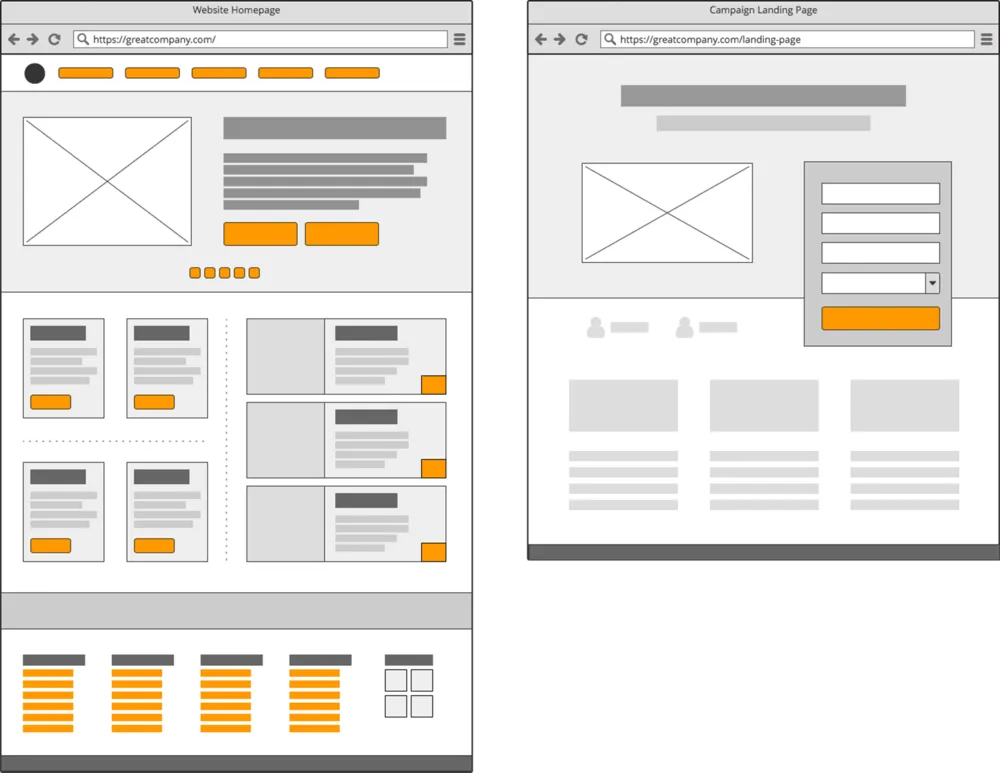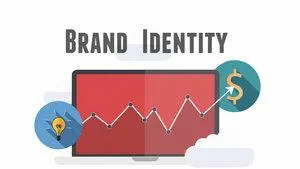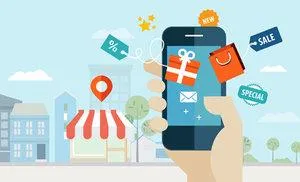LANDING PAGES
Attract a specific audience and deliver a personalized experience.
SERVICES
We Build and Maintain Landing Pages
Landing pages allow businesses to attract a specific audience, deliver a personalized experience, and generate leads. Our landing pages are proven to help companies stand out against their competition and are a cost-effective way to improve conversions, and measurable ROI.
We enjoy developing landing pages because it’s another chance for our exhaustive research and strategy to come to life through targeted content creation for your SEO, SEM, and social marketing campaigns. We even expand the concept into complete vertical marketing gateways that go far beyond building a single landing page, but in fact gives target audiences an entire microsite.

Home Page vs. Landing Page
GATEWAY LANDING PAGES
Gateways are built around a core gateway landing page which targets a specific audience with a precise need—but the supporting content and resource articles (other pages) are what gives the landing page authority.
The gateway landing page serves as an overview of the service, industry, or location—and answers specific questions based on the need it’s serving. This is also where the primary (e.g., fill out a form, schedule a demo) and secondary (e.g., sign up for our newsletter, learn more about our business/services) conversion points will live. Each supporting page will focus on topics specific to the media industry, such as common challenges, big-data trends, live streaming solutions, and security. This is considered the “evergreen” portion of the gateway, evergreen meaning it will be relevant for a long period of time and is not dated, in the way a blog post is.
Once the gateway has launched it will begin to quickly rise up the search engine ranks as it builds authority, however, like all marketing efforts if the gateway isn’t maintained the content’s efficacy will eventually plateau and even begin to fizzle out, especially in highly competitive industries. That’s okay though, maintaining a gateway is relatively easy. Just keep producing content by writing related blogs (one per month) and case studies (one per quarter) and occasionally refresh and expand the static content on the gateway.

PPC LANDING PAGES
While SEO leads our content marketing efforts with most clients, we never ignore the power of pay-per-click advertising. In fact, it’s been found that Google’s paid ad search results account for over half of clicks from buyers with the intent to buy. Needless to say, it’s not a segment that should be overlooked. When you’re paying to drive traffic to a PPC landing page it’s crucial to not only follow best practices when building and maintaining the gateway landing page, but also continually track on-page bounce-rates, conversion ratios, and heatmaps in order to make quick changes to underperforming pages and sections. This analysis can also help inform A/B testing, market segmentation, and future content creation.
A STRONG PPC LANDING PAGE CONTAINS A FEW VITAL ELEMENTS:
A direct headline and supporting tagline
A list of benefits and features
Strong supporting visuals that appeal to audience’s emotional side
Trust symbols (e.g., logos of companies that trust you or customer reviews)
Social proof (e.g., Twitter feed, Yelp reviews, Facebook likes)
A clear call to action
A lead capture form
SOCIAL MEDIA LANDING PAGES

Many of the same principles of gateway landing pages design apply to social media landing pages, but we wanted to make it clear that we create dedicated landing pages for social media campaigns, too. The main difference with social media landing pages is considering where the target audience is coming from. While each social network will share brand voice, your audience might be different and your tone and message length should adjust accordingly.
SEO LANDING PAGES
An SEO landing page is a keyword-focused landing page that follows the same process as gateway, PPC, and social media landing pages. Successful SEO landing pages include compelling, yet concise copy, engaging design, reputable trust symbols, a clear call to action, and a lead capture form. In fact, SEO landing pages are the foundation of every vertical marketing campaign as they serve as the central, hub page that supporting content links to.
RELATED SERVICES
GOOGLE ADVERTISING
SEO l SEM
SOCIAL MEDIA ADVERTISING
GRAPHIC DESIGN
DIGITAL MARKETING
READY TO START YOUR CAMPAIGN WITH AN OPTIMIZED LANDING PAGE?
Fill out the form or give us a call 213-261-1928; we’re happy to answer all your questions and even brainstorm with you!
KNOWLEDGE PORTAL

HOW BRAND IDENTITY IS DEFINED
Aug 13, 2019
All the components related to a product, service, company, or person is “brand identity.” Some of these items are the name, logo, tone, tagline, typeface, and shape that create an appeal. Brand identity is a separate category from brand image.

THE VIRTUAL MARKETPLACE IS RESHAPING RETAIL
Jul 23, 2019
Unlike e-commerce sites that involve businesses selling their own products through a website, virtual marketplaces are where third-party sellers can do business. Amazon and eBay are popular examples of virtual marketplaces. Also known as e-commerce marketplaces, such sites may feature individual traders, large-scale manufacturers of goods, or anything in between.

WELL BUILDING STANDARD – THE NEXT BIG THING IN BUSINESS
Jul 19, 2019
Our world is getting greener by the day. As a global community, we are trying vigorously to recycle more, waste less, and become more efficient in everything that we do. Now, with the green building trend towards sustainability firmly in place, the WELL Building Standard is helping to spearhead the next big wave of change – making buildings healthier and greener for those of us who inhabit them.

CRAFTING YOUR CONTENT STRATEGY TO CREATE USEFUL CONTENT
Jul 15, 2019
Not all content types work for all audiences. For example, the content strategy for a B2B could be to create content that requires a considered decision, whereas content for a B2C may be to stimulate an impulse buy. In this case, the B2B content should focus on establishing an authoritative profile for that business and providing more educational resources (quadrant 1). B2C content, on the other hand, should target users with emotion (quadrant 4). This was put best by Richard Vaughn and his FCB grid(3).
LETS GET STARTED
READY TO START A PROJECT OR REALLY CURIOUS ABOUT WHAT WE CAN DO FOR YOU? DROP US A NOTE OR GIVE US A CALL (213) 444-2413; WE LOVE ANSWERING QUESTIONS AND BRAINSTORMING IDEAS!

HOME | SERVICES | COMPANY | KNOWLEDGE BASE | CONTACT US | CAREERS
CALL US: (213) 444-2413
©2009-2022 Holding Company: The South Bay Project, Inc. | Meta CMO™ | Meta Ads, LLC | Site design by us.